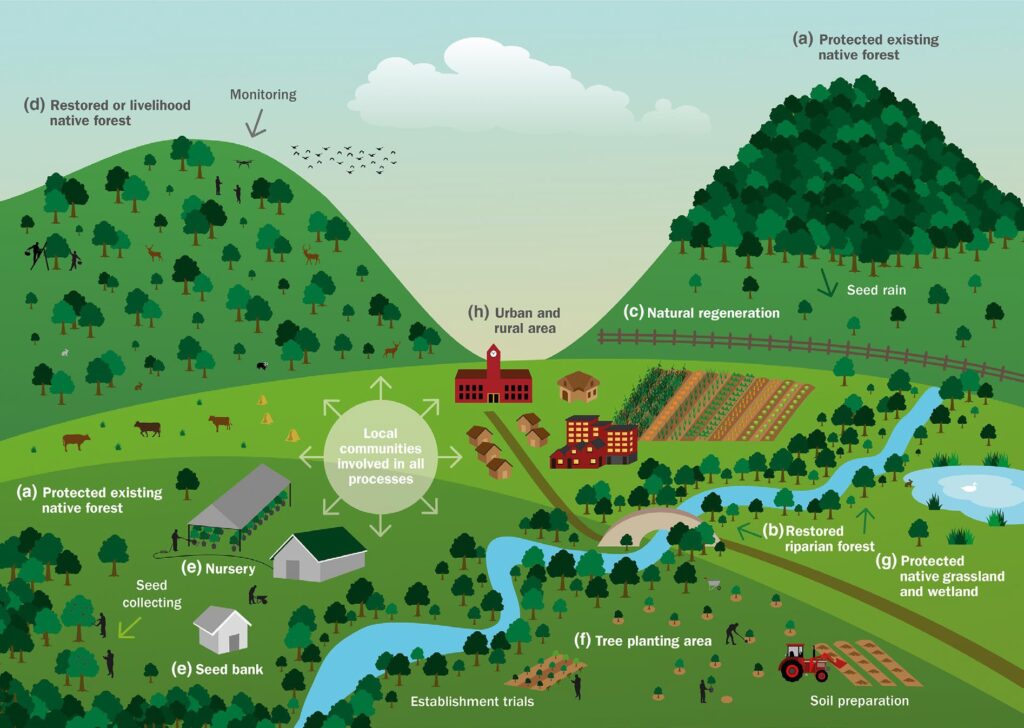The livelihoods of more than 1.3 billion people depend on forest resources [1]. These people reside in the southern regions and represent about 20% of the world’s population! Are they completely sovereign of their incomes and their forests…?
Forests provide essential products and services such as food, medicines, building materials, shade, pollution filters, biodiversity maintenance and many others [2]. They are also essential in the fight against climate change [3]. Trees have been determined to grow most efficiently around the equator. In this geographical area, sunshine rates and temperatures are favorable to the rapid development of forests [4]. We can therefore well imagine why there are a panoply of tree planting projects in the countries of the south.
These initiatives are, for the most part, led by international organisms and governments. Based on premise of the importance of maintaining the exploitation of forests resources for certain populations, these plantations are often for profit [3]. According to oral traditions, some cultures see forests as the links between the spiritual world of their ancestors and their own. These values and their expressions are unique to each community. However, there is little information on the evolution of these traditions in today’s world, especially in relation to the massive use of forest resources and deforestation [5].
At the same time, the tropical forest landscape has been profoundly modified by deforestation over the past fifty years and agriculture is the main driver [6]. No global slowdown in deforestation has been reported [7], but it is undeniable that it must be curbed as quickly as possible to increase carbon capture areas. Nevertheless, several major international efforts are being put into reforestation and afforestation. The “Bon Challenge” aims to restore 350 million hectares of degraded forest landscapes by 2030 [8] and the “plant a Billion Trees” campaign, led by the Nature Conservancy, aims to plant 1 billion trees worldwide [9].
We could not draw up an exhaustive list of all these projects since there is an impressive diversity of them. They also operate on multiple scales and methods, but their missions are common: planting trees on degraded land that has already been forested (reforestation) or planting trees on vacant land that has never been forested (afforestation) while improving the quality of life of local communities through their involvement in projects.
But are these local communities really involved in the projects? Have they been asked for their opinions and do these projects really improve their quality of life?
Several organizations and scientists are investigating these nature-based solutions. While several studies extricate different levels of ambition and potential, they conclude that well-planned ecosystem restoration can intervene relevantly in interrelated crises of climate, biodiversity loss and poverty [10]. Communities in the south can therefore benefit from these projects.
However, the metric of forest cover evolution to determine the success of a project is often favored over the assessment of its social impact. Independent studies that evaluate the social metrics of these projects claim that they fail at this level. They do not improve the quality of life of local communities [11] and they sometimes lead to conflicts in land possession as well as in respect for the rights of communities [12]. These global actions are derived from numerical models. These areas available for tree planting are determined from databases that can overshadow the importance of these lands to communities (agriculture, living spaces) [13]. It was noted that these projects came from so-called “top-down” actions, i.e., from government agencies or organizations with significant notoriety. Several studies argue that one of the biggest obstacles to the success of ecological restoration is the lack of policies that consider the participation of local communities in decision-making surrounding these initiatives [14] [2] [15].
Vietnam’s national reforestation program is seen as a major failure in poverty reduction and economic development. Conversely, 10 million people have been lifted out of poverty thanks to the Mountain-Lake-Program in China. This same project is responsible for the 30% increase in forest area in the region cover over a 20-year period [16]. The major difference between these 2 initiatives is the involvement of the communities in the whole project. The same conclusions are drawn in Africa where “bottom-up” programs that concretely encourage all stakeholders at every stage are the most successful in ecological, economic, and environmental sectors. These initiatives are, for the most part, smaller-scale projects.

Figure 1: Example of a successful reforestation project that involves all stakeholders and integrates notions of ecosystem-based management by moving away from monoculture [16].
Communities are heterogeneous units in which various needs, forces and flaws intertwine [2]. The upstream understanding of this dynamic is crucial so that the forests planted in these territories have a maximum impact in the fight against climate change in the long term. After all, these communities are the ones who will take care of the trees and who will rub shoulders with them!
Notwithstanding the economic benefits of diversifying local employment generated by these projects, there is a strengthening of social ties between smallholders. Community reforestation projects lead to significant knowledge sharing. Increasing the capacities and literacy of participants [15]. The inclusion of women and marginalized groups in reforestation reduces their socio-economic and climate vulnerability by facilitating their access to resources [2].
Easier access to resources, enhanced food security. By improving their economic capacity, households can obtain larger quantities of food to support themselves [16]. Sometimes, organizations introduce agroforestry into ecosystem-based plantation management models. This concept reinforces the food security of populations in the long term since trees are planted with crops. This technique is also important for the economic development of regions and for carbon sequestration [17].
All these factors of inclusion of communities are important components in the quest to achieve climate balance and in that of achieving the United Nations Sustainable Development Goals. Communities in the south are the least responsible for climate change, but they are already suffering the most severely from its impacts [11]. Exacerbating their vulnerability should be avoided; we must help pay their bill, which will continue to add up in the years to come. The ecological crisis induces profound social and economic impacts that greatly deserve to be addressed now to mitigate their current and future impacts. Planting trees in the tropics to achieve climate balance, but also to move forward in an equitable world where everyone can meet their basic needs. It is to rise for climate justice and for the resilience of populations!
Text written by:
Alexie Roy-Lafontaine, Scientific Writer for the Web and Social Networks.

